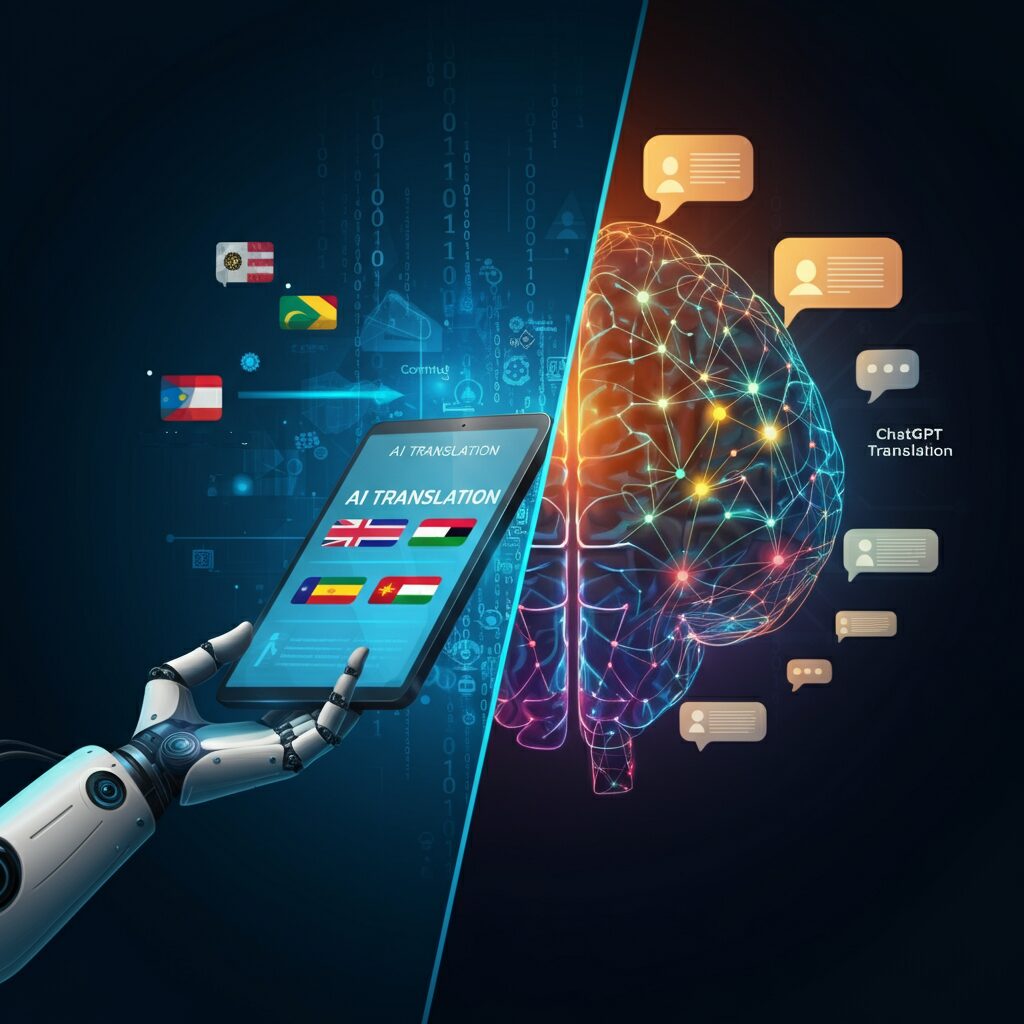Key Points
- AI translation tools are designed for fast, structured translations, while ChatGPT translation focuses on fluency and nuance, making it better suited for conversational and creative content.
- AI translation excels in large-scale, technical, and business-related translations, while ChatGPT is ideal for content adaptation, marketing, and informal communication.
- AI translation may struggle with cultural nuances, and ChatGPT can produce inconsistencies. Choosing the right tool depends on your specific needs and the importance of precision.
The demand for fast and efficient translation has surged. Businesses, academics, and everyday users rely on translation tools to bridge language barriers and facilitate communication. Among the most advanced translation methods available today are AI-powered translation tools and ChatGPT-based translation. While both leverage artificial intelligence, they operate differently and cater to distinct user needs.
So, which translation method is best for you? This article explores the fundamental differences between AI translation tools and ChatGPT translation, their advantages and limitations, and how to choose the right one based on your specific requirements.
Understanding AI Translation
What Is AI Translation?
AI translation refers to automated language translation powered by machine learning, neural networks, and large-scale data processing. These tools analyze vast multilingual datasets to predict and generate accurate translations. Some of the most widely used AI translation tools include:
Below are some of the most commonly used AI translation tools, each designed to provide fast and scalable translations across multiple languages:
One of the most popular AI translation tools, Google Translate supports over 100 languages and offers features like text, speech, and image translation. It uses neural machine translation (NMT) to improve accuracy and fluency.
An AI translation tool that aggregates multiple AI and LLM translation engines, allowing users to compare outputs and select the best option based on quality scores, key term insights, and real-time analysis.
Known for its high-quality translations, DeepL uses deep learning algorithms to produce natural-sounding translations, making it a preferred choice for professionals and businesses.
A versatile tool that integrates with Microsoft Office, Teams, and other applications, making it ideal for businesses and organizations.
How AI Translation Works
AI translation operates through advanced neural networks that analyze vast amounts of multilingual text data. These systems improve over time and learn from previous translations to enhance accuracy. Here’s how AI translation typically works:
- Neural Machine Translation (NMT):
Modern AI translation tools use neural networks trained on millions of translated texts to provide more accurate and natural-sounding translations.
- Data-driven approach:
AI translation models improve over time as they process more data, making them increasingly accurate.
- Context recognition:
Advanced models attempt to consider the context of sentences rather than translating words in isolation.
Strengths of AI Translation
AI translation offers several benefits that make it a powerful tool for businesses and individuals looking for quick and scalable translation solutions:
- Speed & Scalability:
AI translation can process large volumes of text instantly, making it ideal for businesses handling multilingual content.
- Cost-effectiveness:
Many AI translation tools are free or offer affordable pricing for bulk translations.
- Integration capabilities:
AI-powered translation is embedded in software, websites, customer service chatbots, and legal documentation tools.
Limitations of AI Translation
Despite its efficiency, AI translation comes with certain drawbacks that may affect translation quality in specific scenarios:
- Loss of nuance and context:
AI models often struggle with idioms, humor, and culturally specific phrases.
- Limited industry specialization:
While some models cater to legal or medical translations, they may not always produce the level of precision required.
- Lack of personalization:
AI translations are often rigid and cannot be customized to suit different tones or styles.
Understanding ChatGPT Translation
What Is ChatGPT Translation?
ChatGPT is an advanced Large Language Model (LLM) developed by OpenAI. Unlike conventional AI translation tools, it generates translations dynamically based on deep contextual understanding and conversational AI.
How ChatGPT Translation Works
ChatGPT translation differs from traditional AI translation by offering a more interactive and adaptive approach. Instead of relying solely on predefined datasets, it understands and responds to nuanced language patterns. Here’s how it works:
- Context-aware translation:
ChatGPT processes entire paragraphs to ensure coherence in translation rather than translating sentence by sentence.
- Conversational adaptability:
Unlike AI translation tools, ChatGPT understands tone and style, making translations more natural.
- User-interactive approach:
Users can refine translations by asking for modifications, making it a more flexible tool for translation needs.
Strengths of ChatGPT Translation
ChatGPT translation provides several advantages that make it particularly useful for creative and conversational content:
- Fluent and natural phrasing:
ChatGPT translation is more human-like, making it ideal for creative content and natural dialogue.
- Great for localization and content adaptation:
ChatGPT understands cultural nuances, making it more effective for marketing and storytelling.
- Allows user refinements:
Users can provide feedback to adjust translations dynamically, ensuring the best possible output.
Limitations of ChatGPT Translation
While ChatGPT excels at generating natural-sounding translations, it also has limitations that may impact its usability:
- Inconsistencies and hallucinations:
ChatGPT sometimes generates plausible but incorrect translations.
- Not optimized for real-time use:
Unlike AI translation tools, it does not provide instant translations for live communication.
- Limited domain-specific accuracy:
While it can handle specialized topics, it is not as fine-tuned for legal, medical, or technical documents.
Key Differences: AI Translation vs. ChatGPT Translation
To better understand the distinctions between these two translation methods, let’s compare them across key factors:
| Factor | AI Translation | ChatGPT Translation |
| Accuracy | Good for structured sentences but struggles with idioms and informal speech. | Stronger at capturing nuance and context. |
| Context Awareness | Limited; translates sentence by sentence. | Understands broader context across paragraphs. |
| Fluency & Naturalness | Can sound robotic or unnatural. | More human-like phrasing and conversational tone. |
| Industry Terminology | Specialized models exist for legal, medical, and technical fields. | Not always precise in industry jargon. |
| Customization | Some tools allow minor customization. | Can be tailored to user preferences dynamically. |
| Real-time Use | Ideal for fast, automated translations. | Not optimized for real-time applications. |
| Best For | Websites, customer service, multilingual documents. | Creative writing and nuanced communication. |
When to Choose AI Translation vs. ChatGPT Translation
Understanding when to use each tool can help you make the best choice based on your needs. If you require fast, large-scale, and structured translations, AI translation tools are the best option. They are ideal for legal documents, technical manuals, websites, and customer service applications where accuracy and consistency are crucial.
On the other hand, if your translation needs involve creativity, cultural adaptation, and conversational tone, ChatGPT translation is the better choice. It is especially useful for marketing content, storytelling, personal communication, and localization projects where a human-like, nuanced approach is needed. By considering the strengths of both tools, you can decide which best aligns with your specific translation goals.
Challenges and Ethical Considerations
Before choosing a translation tool, it’s important to consider the challenges and ethical concerns associated with AI-based translation technologies:
- Bias and inaccuracies:
AI models may unintentionally reinforce biases present in their training data.
- Privacy concerns: AI translation tools often require access to user data, raising concerns about confidentiality.
- Dependence on automation:
Over-reliance on AI translation can lead to errors in sensitive contexts such as legal or medical translations.
- Intellectual property issues:
AI-generated translations may raise copyright and ownership concerns.
Conclusion: Which One is Right for You?
Choosing between AI translation and ChatGPT translation depends on your specific needs, priorities, and the type of content you are translating. AI translation is ideal for businesses and individuals who need fast, automated, and scalable translations for structured content such as websites, product descriptions, and legal or technical documents. It offers real-time translations and integrates well with various platforms, making it a great choice for large-scale multilingual operations. However, it may lack the nuance and contextual understanding required for more complex or creative translations.
ChatGPT translation, on the other hand, is better suited for situations that require human-like fluency, conversational tone, and contextual accuracy. It excels in marketing content, storytelling, and localization, where cultural adaptation and personalization are crucial. However, it may not be as reliable for highly specialized or industry-specific translations without human review.
Ultimately, the right tool for you will depend on whether you prioritize speed and efficiency or flexibility and contextual depth. By understanding the strengths and limitations of each, you can make an informed decision that best serves your translation requirements.



































